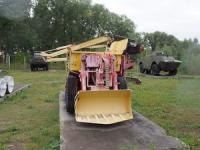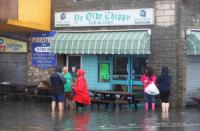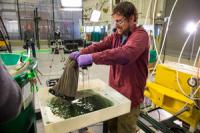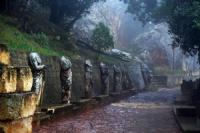-
Past quakes at Calif. fault portend abrupt sinking of Seal Beach wetlands
A new study shows evidence of abrupt sinking of the wetlands near Seal Beach caused by ancient earthquakes that shook the area at least three times in the past 2,000 years — and it could happen again, the researchers say. The paleoseismology study reveals that the wetlands at the National Wildlife Refuge Seal Beach, a nearly 500-acre area located within the Naval Weapons Station Seal Beach and next to the communities of Seal Beach and Huntington Harbor, are susceptible to rapid lowering in elevation during large — over 7.0 magnitude earthquakes.
-
-
Nextgen robots for nuclear clean-up

The cost of cleaning up the U.K.’s existing nuclear facilities has been estimated to be between £95 billion, and £219 billion over the next 120 years or so. The harsh conditions within these facilities means that human access is highly restricted and much of the work will need to be completed by robots. Present robotics technology is simply not capable of completing many of the tasks that will be required. A research a consortium to build the next generation of robots that are more durable and perceptive for use in nuclear sites.
-
-
The old, dirty, creaky U.S. electric grid would cost $5 trillion to replace. Where should infrastructure spending go?

The electric grid is an amazing integrated system of machines spanning an entire continent. The National Academy of Engineering has called it one of the greatest engineering achievements of the twentieth century. But it is also expensive. By my analysis, the current (depreciated) value of the U.S. electric grid, comprising power plants, wires, transformers and poles, is roughly $1.5 to $2 trillion. To replace it would cost almost $5 trillion. That means the U.S. electric infrastructure, which already contains trillions of dollars of sunk capital, will soon need significant ongoing investment just to keep things the way they are. There is no path toward shoring up or upgrading the U.S. electric grid that does not require investment – even just maintaining what we have will cost hundreds of billions, if not trillions, of dollars over the next decade. The bigger question is: As we continue to replace and rebuild this amazing grid, what technologies should we focus on?
-
-
EPA awards $100 million to Michigan for Flint water infrastructure upgrades
The U.S. Environmental Protection Agency (EPA) last week awarded a $100 million grant to the Michigan Department of Environmental Quality to fund drinking water infrastructure upgrades in Flint, Michigan. The funding, provided by the Water Infrastructure Improvements for the Nation Act of 2016, or WIIN, enables Flint to accelerate and expand its work to replace lead service lines and make other critical infrastructure improvements.
-
-
Extreme sea levels could endanger European coastal communities

Massive coastal flooding in northern Europe that now occurs once every century could happen every year if greenhouse gas emissions continue to rise, according to a new study. New projections considering changes in sea level rise, tides, waves and storm surge over the twenty-first century find global warming could cause extreme sea levels to increase significantly along Europe’s coasts by 2100. Extreme sea levels are the maximum levels of the sea that occur during a major storm and produce massive flooding.
-
-
Map shows seawater threat to California Central Coast aquifers
More than half the world’s population lives within 37 miles (60 kilometers) of the coast, and three-quarters of all large cities are located in coastal areas. Many coastal communities rely on groundwater to satisfy their drinking and farming water needs. But removing too much of that groundwater can change the fluid pressure of underground aquifers, drawing seawater into coastal aquifers and corrupting water supplies. Saltwater intrusion is often irreversible. Researchers have transformed pulses of electrical current sent 1,000 feet underground into a picture of where seawater has infiltrated freshwater aquifers along the Monterey Bay coastline.
-
-
“Fishing out” radioactive elements from nuclear waste
Scientists have revealed how arsenic molecules might be used to “fish out” the most toxic elements from radioactive nuclear waste — a breakthrough that could make the decommissioning industry even safer and more effective. “Nuclear power could potentially produce far less carbon dioxide than fossil fuels, but the long-lived waste it produces is radioactive and needs to be handled appropriately,” one scientists said.
-
-
Offshore fault system could produce onshore magnitude 7.3 quake in southern California
A fault system that runs from San Diego to Los Angeles is capable of producing up to magnitude 7.3 earthquakes if the offshore segments rupture and a 7.4 if the southern onshore segment also ruptures, according to a new analysis. “This system is mostly offshore but never more than four miles from the San Diego, Orange County, and Los Angeles County coast,” says the lead author. “Even if you have a high 5- or low 6-magnitude earthquake, it can still have a major impact on those regions which are some of the most densely populated in California.”
-
-
Reusable sponge could revolutionize oil spill and diesel cleanup

When the Deepwater Horizon drilling pipe blew out seven years ago, beginning the worst oil spill in U.S. history, those in charge of the recovery discovered a new wrinkle: the millions of gallons of oil bubbling from the sea floor weren’t all collecting on the surface where it could be skimmed or burned. Some of it was forming a plume and drifting through the ocean under the surface. Now, scientists have invented a new foam, called Oleo Sponge, that addresses this problem.
-
-
Purifying wastewater with sunlight
Chemists have found a way to use sunlight to purify wastewater rapidly and cheaply, and to make self-cleaning materials for buildings. The technology uses modified titanium dioxide as a photocatalyst that works with sunlight, unlike other leading water purification products on the market that need ultraviolet light.
-
-
Knowledge gaps on protecting cultural sites from climate change

Researchers searched worldwide for peer-reviewed studies of cultural resources – archaeological sites, natural landscapes, and historic buildings — at risk due to climate change. About 60 percent of the studies referenced sites in Europe, most commonly in the United Kingdom. Another 17 percent of the research covered sites in North America, a majority of them in the United States. About 11 percent dealt with resources in Australia and the Pacific Islands and 10 percent mentioned Asia, mostly China. All but six of the 124 studies were published in English-language journals, with South America and Africa rarely represented in the research. “We see a significant gap in knowledge of how to adapt to climate change and preserve cultural resources for future generations,” says one researcher.
-
-
Preventing nuclear waste seepage
Nuclear waste is a reality, whether remnants of nuclear weapons or the byproducts of nuclear power plants. While we aren’t at risk of an attack from a giant radioactive lizard, nuclear waste can still pose threats to human health. The best way to safely store and contain nuclear waste is by mixing it into a cement grout and storing it in large concrete vaults. Researchers are testing the permeability of these grout mixtures and in turn, the ability for nuclear materials to eventually flow through the solidified grout and into the environment.
-
-
Better communication key to reducing earthquake death toll

A major problem in conveying earthquake risks to the public is that scientists are unable to predict when, where, and with what strength the next earthquake will strike. Instead, they use probabilistic forecasting based on seismic clustering. Earthquake experts have long grappled with the problem of how to convey these complex probabilities to lay persons.
-
-
Why farmers and ranchers think the EPA Clean Water Rule goes too far
President Trump issued an executive order 28 February directing federal agencies to revise the Clean Water Rule, a major regulation published by the Environmental Protection Agency and the Army Corps of Engineers in 2015. Framers and ranchers are particularly worried that the Clean Water Rule could expand federal regulations that impact their private property rights. However, regulatory agencies and the regulated community need to know the limits of the Clean Water Act’s reach so they can take appropriate measures to protect water resources. If the rule is scrapped, we still will need to know which water bodies require protection under the law. If the Trump administration withdraws or weakens the Clean Water Rule, it is likely to leave regulators interpreting case by case whether tributaries and adjacent waters are covered, as they have been doing since 2006, and land and water owners guessing about what they can do with their resources. So in the end, repealing the rule won’t answer the underlying question: how far upstream federal protection extends.
-
-
California's San Joaquin Valley still sinking
Since the 1920s, excessive pumping of groundwater at thousands of wells in California’s San Joaquin Valley has caused land in sections of the valley to subside, or sink, by as much as 28 feet (8.5 meters). This subsidence is exacerbated during droughts, when farmers rely heavily on groundwater to sustain one of the most productive agricultural regions in the nation. Long-term subsidence is a serious and challenging concern for California’s water managers, putting state and federal aqueducts, levees, bridges, and roads at risk of damage. Already, land subsidence has damaged thousands of public and private groundwater wells throughout the San Joaquin Valley. Furthermore, the subsidence can permanently reduce the storage capacity of underground aquifers, threatening future water supplies.
-
More headlines
The long view
Helping Strengthen America’s Critical Infrastructure
Everyday life depends on a robust infrastructure network that provides access to running water, communications technology and electricity, among other basic necessities. The experts who keep our national infrastructure secure and resilient also need a strong network to share their knowledge and train the next generation of professionals capable of solving complex infrastructure challenges.
AI and the Future of the U.S. Electric Grid
Despite its age, the U.S. electric grid remains one of the great workhorses of modern life. Whether it can maintain that performance over the next few years may determine how well the U.S. competes in an AI-driven world.
Using Liquid Air for Grid-Scale Energy Storage
New research finds liquid air energy storage could be the lowest-cost option for ensuring a continuous power supply on a future grid dominated by carbon-free but intermittent sources of electricity.
Enhanced Geothermal Systems: A Promising Source of Round-the-Clock Energy
With its capacity to provide 24/7 power, many are warming up to the prospect of geothermal energy. Scientists are currently working to advance human-made reservoirs in Earth’s deep subsurface to stimulate the activity that exists within natural geothermal systems.
Experts Discuss Geothermal Potential
Geothermal energy harnesses the heat from within Earth—the term comes from the Greek words geo (earth) and therme (heat). It is an energy source that has the potential to power all our energy needs for billions of years.
